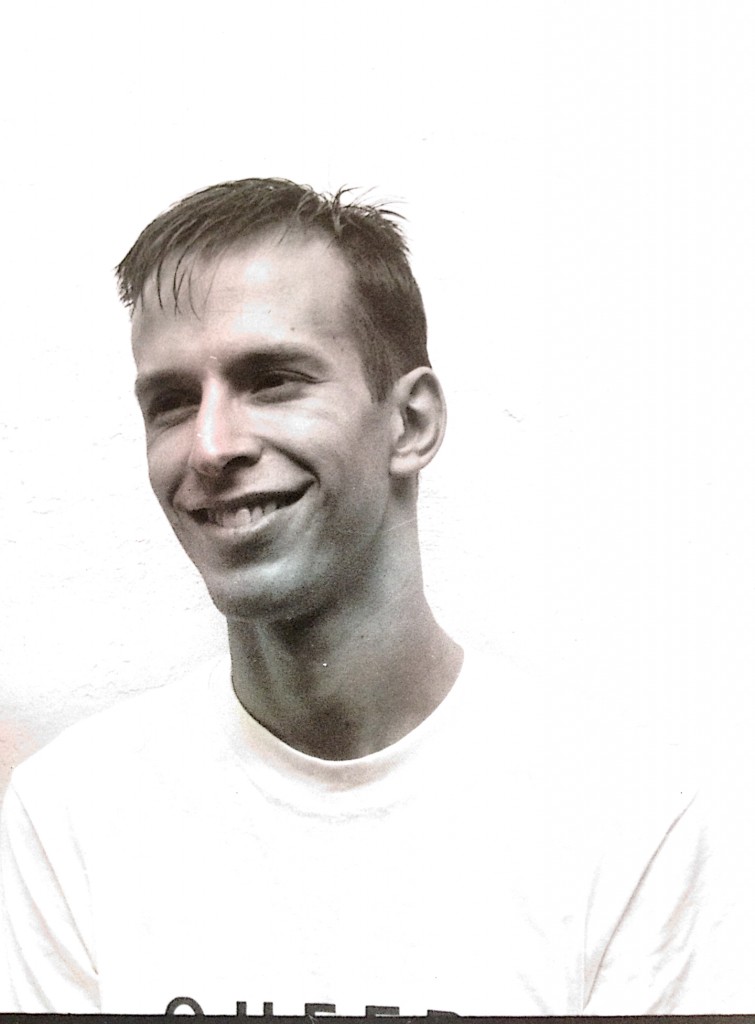At two concerts next month (14 June and 15 June), my dear friends the Acacia Quartet will premiere this work, Night Vigil.
During those concerts, they will also perform another excerpt from my memoir quartet, Don’t Leave Me This Way.
As ever, I’m moved and grateful for Acacia’s embrace of this music.
Update: the recording below is from the studio album of the entire AIDS Memoir Quartet released by Vexations840.
The story of Bruce Brown, the most prominent of ACT UP activists, is inseparably bound up in my story of ACT UP that I tell elsewhere in this memoir quartet. Night Vigil is the final part of Bruce’s story.
On several occasions Bruce had made it clear to me that if he ever lost his eyesight, it would mean that the balance between quality and quantity of life had tipped over.
Every person with advanced AIDS faced this balance. As AIDS progressed and the number of cancers and opportunistic infections in the body accumulated, at what point do you decide that having more life was unacceptable? The moments of bearable pain will eventually be outnumbered by the unbearable ones. But’s not just about physical pain. It’s also about dignity.
Bruce was starting to go blind from cytomegalovirus retinitis, one of the infections that characterized late-stage AIDS. For a year he was treated with ganciclovir. He was one of the first brave patients to ever receive direct injections into the eye. Small amounts into the eye was a far less toxic way to administer this dangerous, side effects-laden drug than conventional large quantities into an arm. When we attended the international AIDS conference in Berlin together in 1992, we traveled with a supply of ganciclovir, and before we left Bruce made me watch and learn how his nurse injected his eye in case we couldn’t find a physician there who knew the new technique and I had to do it. He said it jokingly but this was a time when jokes were accompanied by “You never know”.
By the next year, the CMV was becoming drug-resistant, and Bruce was losing his sight. He was also succumbing to some of the other opportunistic infections like MAC, a diarrhea-causing illness.
By this time, Bruce had been an activist for 4 years and accomplished, against the odds, a lot of the things he wanted to do in AIDS. And he had lived a full life.
Born in Quincy, Illinois, he was a classical organist who attended the famed Oberlin Conservatory of Music, then moved to San Francisco where he studied and worked with the early music pioneer Laurette Goldberg. With her he helped found the now-legendary Philharmonia Baroque Orchestra in 1981. He came to Sydney to be with his Australian boyfriend Gary; here he was an organist at St Stephen’s Uniting Church and a federal research officer at the Australian Broadcasting Corporation’s concerts division, posts he held until he was too ill for full-time work, though he then devoted himself to something even more time-consuming, AIDS activism.
Going blind was Bruce’s signal that his quality of life had slipped below the threshold and that no quantity of life could make up for it. In late 1993 he told me that he was planning to end his life. It was a calm, lucid decision made over a long time. He told me that he wanted me to be the executor of his estate and gave instructions about what to do with his belongings.
I was one of three people, all ACT UP activists, whom he wanted present at the moment he would suicide. He asked, would I agree to be there, making it clear that if I chose not to be, it was entirely all right with him. I said there was no question.
Under Australian law, it is a criminal offence to assist a suicide. Bruce obtained his means of death unlawfully. We knew the law. To be safe, no one could be in the same room as Bruce when he took the action. Which was as inhumane a thing as one human being could do to another, to force an already solitary death to be lonely.
The date he chose was 16 December 1993, a Thursday.
He took Lois, Kirsty and me into his bedroom, one at a time, to say goodbye. When it was my turn, he took off his watch and said I want you to have this.
The law is an ass. I did end up staying in the room when Bruce carefully measured out the pills for the overdose. He swallowed the large number of pills with water, and he gagged. He looked up at the ceiling and he said, dear God please don’t let me throw up. So I knew then, because I didn’t know before, that Bruce believed in God.
I said, one day, I’ll see you again.
We just waited through the night as Bruce slept. We were three islands, that night, barely speaking. I remember, once Kirsty said, “I think I’m slowly going mad.” We drank coffee and I listened to music. I played a couple of CDs from Bruce’s collection. One was an anthology of Maria Callas, which included Giordano’s ‘La mamma morta’, an aria I had loved since the movie Philadelphia. And Peter Serkin’s performance of Bach’s Goldberg Variations, which I played a number of times through that night. In the morning, after the sun had been shining for a while, we decided to go into the bedroom again. Bruce was still sitting up in bed, exactly the same position I left him over 12 hours ago but with his head laying down on his chest. I touched him and he was cold. We called the police, as we had planned to. The police arrived, with an ambulance and I remember one medic swearing a little because Bruce’s body was difficult to move as rigor mortis had set in. This degree of rigor told me that Bruce had died quite early the previous evening. The barbiturates were a success.
We divided up the task of making phone calls to friends and family to tell them Bruce had died. I still have his address book that we used to do that. Kirsty drew the straw on calling to his mother in Quincy, who cried on the phone. I called Laurette Goldberg, whom Bruce always referred to as his teacher. I told her that Bruce wanted his collection of music books and recordings to be sent to her, to be part of her famous resource centre called MusicSources. Laurette said that she would create a special section just for them, a section that would always bear his name. Later I found out that she put up a picture of Bruce in that section.
Towards the end of her teaching career, when Laurette was asked who her most memorable students were, she named Bruce amongst them. “Very gifted, died at thirty five”, she said. She lovingly recollected that she had two students named Bruce Alan Brown, “both six feet tall, both gay, both fine harpsichordists.” And she said that Bruce, the Bruce that I knew, was the reason Nicholas McGegan got the job as Music Director of Philharmonia Baroque in 1985, the post he still holds today. Laurette was looking for someone to take over, and Bruce knew Nick from their Oberlin days together, and made the recommendation.
Bruce and I were the only ACT UP activists who were classical musicians, though it was the least of our bonds. We only sometimes spoke about music, though when we did, they were extraordinary conversations. When it came time to write this part of my memoir, I knew that Bruce would appreciate music of the highest sophistication.
According to his son Carl Philipp Emanuel, when Bach was on his deathbed he asked to see one of his own organ works from his youth. It was Wenn wir in höchsten Nöten sein or “When we are in our deepest need”, a chorale with the comforting message that God will never turn his face away. Bach was blind by then. By dictating musical instructions to an assistant, he cleared away the florid ornaments he’d written when he was young, and made a new piece with the revealed simplicity and directness. The new version was renamed Vor deinen Thron tret ich hiermit or “Before your throne, I now appear”, an expression of profound humility from a blind man ready to die. Bruce, an organist enamored of Bach, would have known this piece, I’m sure of it.
So I took this piece and made yet another new piece from it. I let this organ work be refracted by my thoughts, feelings and memories about Bruce and suicide and barbiturates and his watch and his prayer and him sitting up in bed that long night, and I let the light and sound bend and land where it would. The result is a piece of intense serenity, of the highest order of intricacy yet fundamentally heartfelt. In this piece I can sometimes hear Bach’s original music; sometimes it’s in the far distance, out of focus, and sometimes it’s just not there at all. Because I didn’t know when in the night Bruce died, I chose a random place in the score and I wrote down Horatio’s farewell – “good night, sweet prince. And flights of angels sing thee to thy rest”. It was then that I realized why I had written so many trills into the violins. I’d been hearing the fluttering of wings.
There is a passage that sounds like ambulance sirens. I honestly don’t know what it’s doing there. There were no sirens at Bruce’s death. It was quiet. When the police came, they came quietly. There was an ambulance for the body, but they came knowing it was a dead body they’d come for and there was no hurry, no emergency, no sirens. Maybe the sirens are what my unconscious mind wants to hear, that it wasn’t right for the death of the country’s leading AIDS activist to be accompanied by so much silence. Silence equals death, that was the first chant an ACT UP member learns. Action equals life, we chanted. I tried to remove the sirens from the music but it wouldn’t let me. The music would ground to a stubborn halt without the sirens, stonewalling. So the sirens stayed in the piece.
At funerals of ACT UP members, they would sometimes receive a whistle salute. The whistle had been ‘weaponised’ in the hands of ACT UP. It was used at all public demonstrations. Whistles alongside chanting could be heard for city blocks, making us sound large, intimidating, like we meant business.
Lost in old laws of war is the origin of honouring dead warriors by firing weapons in the air. Wars have always had armistices during which the recovery of the wounded, and by extension the dead, is conducted. After the dead and wounded had been tended to, the respective warring party would fire three cannon volleys in the air to signal that it was ready to resume battle.
This piece for Bruce ends with a 3-volley whistle salute. Bruce was tended to. We readied ourselves for the return to battle.
Epilogue:
A mere year and half after Bruce’s death, on 25 May 1995, the Northern Territory of Australia became the first place in the world to pass right-to-die legislation. This lasted nine months, then was overturned by Federal Parliament. Today it remains illegal anywhere in Australia to ask for assistance to die.



{ 1 trackback }